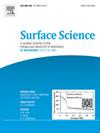H2 dissociation barrier governed by antibonding-state center in defective graphene-supported Cu19 cluster
IF 1.8
4区 化学
Q3 CHEMISTRY, PHYSICAL
引用次数: 0
Abstract
The dissociation of H2 is crucial for hydrogen storage and industrial hydrogenation processes. This study employs ab initio molecular dynamics calculations to explore the mechanisms of H2 dissociation on Cu19 clusters and Cu19 clusters supported by defective graphene. The findings indicate that the defective graphene-supported Cu19 cluster exhibits more dissociation processes compared to the standalone Cu19 cluster, with each corresponding process also having a lower energy barrier. Analysis using crystal orbital Hamilton population at the transition states reveals that for both cluster types, a higher center of the H2 antibonding state correlates with a reduced dissociation barrier. Furthermore, the reduction in the dissociation barrier on the defective graphene-supported Cu19 cluster is linked to an upward shift in the H2 antibonding-state center relative to that on the Cu19 cluster alone.

缺陷石墨烯支持的Cu19簇中H2解离势垒由反键态中心控制
氢气的解离是氢储存和工业加氢过程的关键。本研究采用从头算分子动力学方法探讨了H2在Cu19团簇和缺陷石墨烯支持的Cu19团簇上的解离机制。研究结果表明,与独立的Cu19团簇相比,缺陷石墨烯支持的Cu19团簇表现出更多的解离过程,每个相应的解离过程也具有更低的能垒。利用过渡态的晶体轨道Hamilton居群分析表明,对于这两种类型的簇,H2反键态中心越高,解离势垒越低。此外,在有缺陷的石墨烯支持的Cu19簇上,解离势垒的减少与H2反键态中心相对于单独的Cu19簇的向上移动有关。
本文章由计算机程序翻译,如有差异,请以英文原文为准。
求助全文
约1分钟内获得全文
求助全文
来源期刊

Surface Science
化学-物理:凝聚态物理
CiteScore
3.30
自引率
5.30%
发文量
137
审稿时长
25 days
期刊介绍:
Surface Science is devoted to elucidating the fundamental aspects of chemistry and physics occurring at a wide range of surfaces and interfaces and to disseminating this knowledge fast. The journal welcomes a broad spectrum of topics, including but not limited to:
• model systems (e.g. in Ultra High Vacuum) under well-controlled reactive conditions
• nanoscale science and engineering, including manipulation of matter at the atomic/molecular scale and assembly phenomena
• reactivity of surfaces as related to various applied areas including heterogeneous catalysis, chemistry at electrified interfaces, and semiconductors functionalization
• phenomena at interfaces relevant to energy storage and conversion, and fuels production and utilization
• surface reactivity for environmental protection and pollution remediation
• interactions at surfaces of soft matter, including polymers and biomaterials.
Both experimental and theoretical work, including modeling, is within the scope of the journal. Work published in Surface Science reaches a wide readership, from chemistry and physics to biology and materials science and engineering, providing an excellent forum for cross-fertilization of ideas and broad dissemination of scientific discoveries.
 求助内容:
求助内容: 应助结果提醒方式:
应助结果提醒方式:


